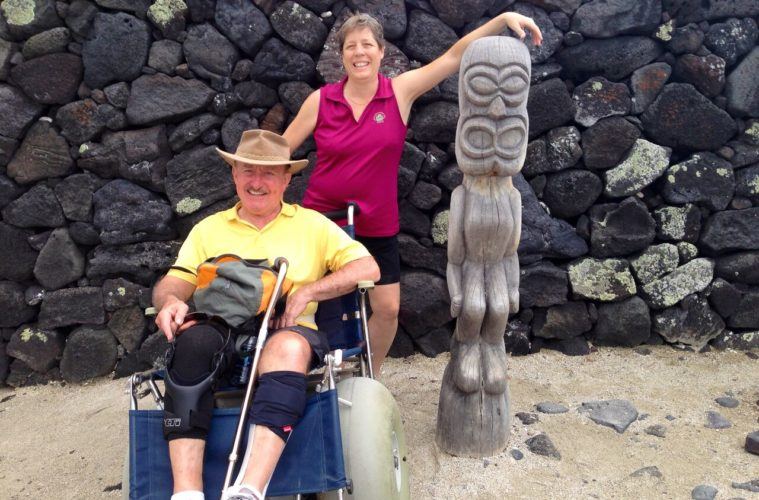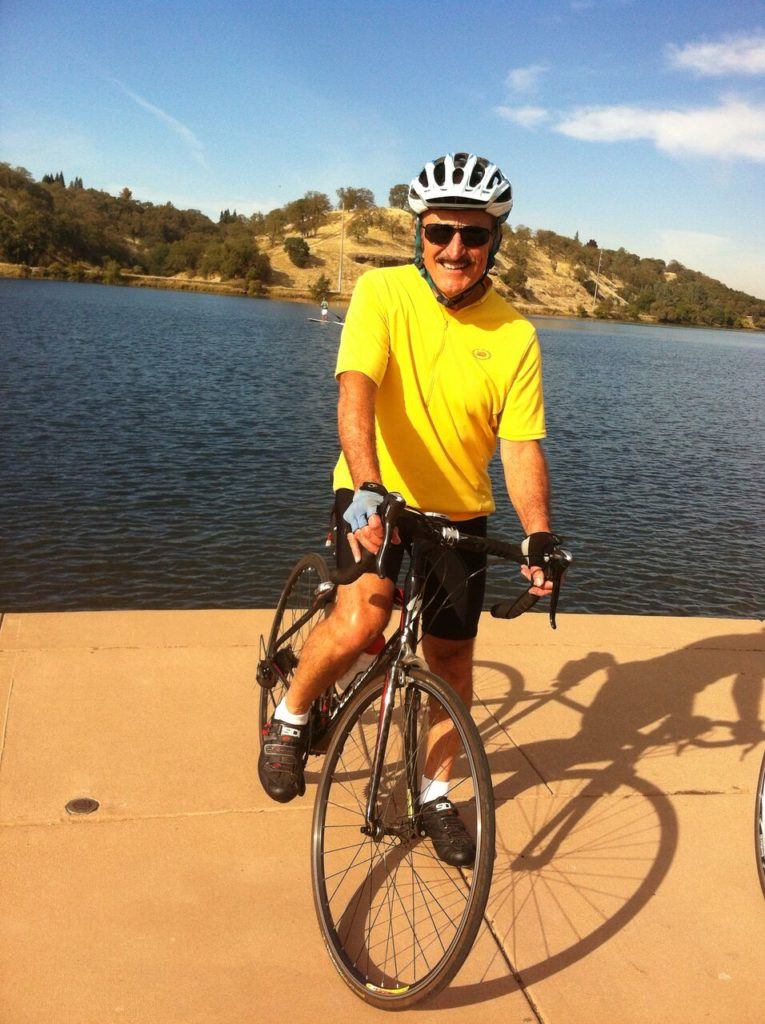 Michael Zannakis came to the U.S. in 1985 on behalf of the Australian Air Force.
Michael Zannakis came to the U.S. in 1985 on behalf of the Australian Air Force.
When F-111 aircraft – multipurpose, tactical fighter bombers capable of supersonic speeds – were sold to the Royal Australian Air Force, McClellan Air Force Base in Sacramento, California, was set up as a place the Australian Air Force people could come to learn about this new aircraft. Since the F-111 was a new swing wing bomber that used new metals and had all new electronics, there was plenty to learn.
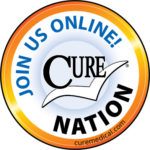 Zannakis came to McClellan Air Force Base as an electronics officer, and that’s when his life changed forever in an unusual way. Zannakis stayed and worked in California until 1987. He shares his story below with the Cure Nation.
Zannakis came to McClellan Air Force Base as an electronics officer, and that’s when his life changed forever in an unusual way. Zannakis stayed and worked in California until 1987. He shares his story below with the Cure Nation.
It starts with a love story.
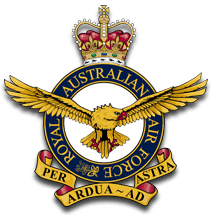 About the last week of my assignment, when I was supposed to return to Australia, I had begun to notice a beautiful young lady with a great smile and sparkling eyes. At first, I didn’t think that much about her because I was recently divorced and had vowed to never remarry.
About the last week of my assignment, when I was supposed to return to Australia, I had begun to notice a beautiful young lady with a great smile and sparkling eyes. At first, I didn’t think that much about her because I was recently divorced and had vowed to never remarry.
During that last week of my assignment, this young lady came up to me and said, “I don’t know who you are, but would you mind sponsoring me for a 1000 mile fund raising tour bicycle ride? The tour is a fund raiser for the American Lung Association.” I learned that her name was Amy Cummings. I smiled and told her, “Yes, I’ll sponsor you under one condition. I’m leaving to go home to Australia in less than a week. I’ll give you my address because I‘m intrigued about this 1000 mile bike trip. I’d like to know what it’s about, and what you do when you pedal a bicycle 1000 miles.”
Amy wrote to me, just like she said she would.
She shared that she and the other riders had taken a train to Seattle, Washington, and then they planned to ride their bikes back to Sacramento, California. The ride would take 2 weeks and they would camp every night.
The American Lung Association provided a “sag wagon” – a support vehicle that carried all the bikers’ camping and cooking equipment, as well as parts to fix problems that they might have with their bikes. The sag wagon was also there to help any cyclist who got a punctured tire or experienced any physical or mechanical problems.
It all sounded like a grand adventure and I was happy to have offered my support.
To sponsor Amy only required a $25 check to the American Lung Association – which wasn’t a bad investment for my future wife. After the 1000 mile bicycle tour, Amy and I continued to write.
When we were beginning our relationship, it was before the Internet, emails, Snapchat and texting. In fact, it took 2 weeks for a letter to arrive to each other after it was sent. It was evident in our conversations that cycling seemed to be our common ground. I rode a bicycle back and forth every day to work and Amy was into extreme cycling and thought nothing of riding the 1000 miles in 2 weeks.

Michael and his wife Amy have shared a deep love of cycling since their relationship began
After some time, I had to come back to the United States for a meeting in Washington, D.C. While there, I made plans to spend some time in Sacramento, where Amy lived. I arrived on a Friday night, called Amy and asked, “What are you doing tonight?” When she replied “Nothing,” I asked, “Would you like to go for a beer and pizza?” to which she responded, “I wish.” “I’m not doing anything either,” I told her. “If you’ll pick me up at the airport, I’ll take you anywhere you say, and I’ll buy you a beer and pizza.” And, so it began.
Although I had told everybody I was never getting married again, I learned I wasn’t in charge of my life. God had different plans for me.
 After returning home, we continued to be pen pals. Within a couple months, Amy planned a trip to Australia and met my family. Before long, it was clear that we were supposed to be together, regardless of the circumstances.
After returning home, we continued to be pen pals. Within a couple months, Amy planned a trip to Australia and met my family. Before long, it was clear that we were supposed to be together, regardless of the circumstances.
I was 42, and Amy was 27, but age wasn’t an issue. Before getting married, we had only even seen each other three times in the 18 months we’d known each other. Today, we’ve been married for 27 years and have a daughter named Jessica, who is 22 years old and serving in the U.S. Navy as an ensign. Jessica is currently in flight school in Pensacola, Florida.
I retired from the Australian Air Force after 23 years of service as a Wing Commander, which was the equivalent of a Lieutenant Colonel in the United States Air Force. When I met Amy, I was a Squadron Leader, which was equivalent to a Major in the US Air Force. I came to this country after I met Amy, took a job with the Sacramento Municipal Utility District, where I worked for 22-1/2 years before I retired.
Cycling Is the Center of the Zannakis Family Workouts
Cycling has always been an important part of our lives. In California, I commuted back and forth to work on my bicycle and on the weekends, Amy and I also did recreational riding. In 2012, I rode my bicycle 5500 miles. Later, Amy and I used to reward ourselves for doing chores around the house on weekends by going on a bike ride to a famous bakery in Folsom, California, about 25 miles from our home and on the edge of Lake Lucerne.
And without warning, everything can change.
On December 17th, 2013, without warning, I was told that I had a stroke in my sleep. However, the doctors eventually realized it was a seizure and I continued to have them for some time. Finally, the doctors decided to go into my skull in an attempt to find out what was causing my seizures. On the day of the surgery, they laid a grid across my brain and induced a seizure to try and isolate the cause. After a day or two, they went back into my brain and scooped out a golf ball size lump of dead brain material.
Michael Zannakis Adjusts to a New Reality
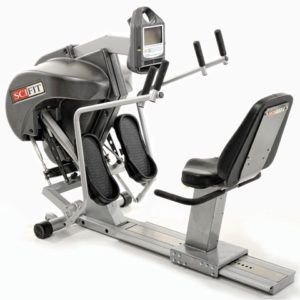 Although the doctors never did identify what was causing my seizures, that operation resulted in complete paralysis on the left side of my body. My left arm and hand wouldn’t work, and my left eye was often cocked to the right. But, my condition continued to improve and I was diagnosed with a spinal cord injury. I began to receive what was called Spinal Cord Injury Functional Integrated Therapy – a non-traditional spinal cord injury rehabilitation. As I continued therapy, I got stronger and stronger.
Although the doctors never did identify what was causing my seizures, that operation resulted in complete paralysis on the left side of my body. My left arm and hand wouldn’t work, and my left eye was often cocked to the right. But, my condition continued to improve and I was diagnosed with a spinal cord injury. I began to receive what was called Spinal Cord Injury Functional Integrated Therapy – a non-traditional spinal cord injury rehabilitation. As I continued therapy, I got stronger and stronger.
The road to recovery.
 Eventually I was able to walk with a cane. Over a long period of testing, I was able to get my driver’s license again. But I truly missed riding my bicycle.
Eventually I was able to walk with a cane. Over a long period of testing, I was able to get my driver’s license again. But I truly missed riding my bicycle.
As I said earlier, my wife Amy was really into cycling and it had been an integral part of our lives. Finally, we discovered recumbent tricycles would work for me, with two wheels on the front and one wheel on the back. With the modifications I needed to ride, the recumbent tricycle cost about $3,000.
I started to learn to ride this tricycle with both my legs strapped onto the tricycle. Since I had function on my right side, I still could use my right hand to operate the gears and the brakes. My wife Amy also bought one of these bikes, which enabled us to ride together again and still be about the same height.
These bikes are ridden close to the ground and are not nearly as tall as a standard bicycle, so there are flags attached to the backs, allowing people to see us better when we’re riding on the road.
 Today, at 70 years old and after several years of experience on the recumbent tricycles, we still make that trip to the bakery in Folsom – although it’s the longest ride we make together these days. We’ve had to adjust our route a bit to avoid some hills and I don’t prefer to ride in the snow anymore, so in the winter rides get less frequent.
Today, at 70 years old and after several years of experience on the recumbent tricycles, we still make that trip to the bakery in Folsom – although it’s the longest ride we make together these days. We’ve had to adjust our route a bit to avoid some hills and I don’t prefer to ride in the snow anymore, so in the winter rides get less frequent.
Amy’s still motivating people and at 55, is a professor of computer science at Sacramento City College.
Michael’s Words of Advice for Newly Injured Friends
 You can sit around and complain about how life has dealt you a bad hand of cards. Or, you can turn lemons into lemonade and make life about taking what you have and doing the very best you can with what you’ve got.
You can sit around and complain about how life has dealt you a bad hand of cards. Or, you can turn lemons into lemonade and make life about taking what you have and doing the very best you can with what you’ve got.
I still can ride my recumbent tricycle, garden and grow vegetables and flowers. For me, I think I have a great life after my injury.

We know some other friendly folks who are rocking their lives after spinal cord injury! Click here to meet the Cure Advocates!
Enjoy Our Free Resources & Articles
 CURE NATION is designed with you in mind, to offer assistance and education when you need it through a personal support program.
CURE NATION is designed with you in mind, to offer assistance and education when you need it through a personal support program.
All of the information you find below and on our related social media pages is meant to guide you to places, topics and, resources that enhance your life, while also connecting you with a growing group of friends.
- Sign up for our free, CURE NATION e-newsletter to have our latest stories delivered directly to you, once a month.
- Get our FREE LIFESTYLE + TRAVEL BOOKS here.
- Have an idea you’d like to share? Let us know.
- Be sure to take a minute to meet our Cure Advocates too.
You may also enjoy:
Kyla Daniels: The Creator of AbleBodied Chef
Nancy Sisson Chooses No Scary Chemicals in Catheters to Support Her Healthy Lifestyle
ParaSportsLive: Bringing Adaptive Sports to Audiences Worldwide
Thriving After SCI: Nick LiBassi of United Spinal Fell 5,000 Feet Without A Parachute
Holiday Gift Ideas for Friends Who Roll
Join Teal on the Hill for Spina Bifida Advocacy
Five Fun Summer Events For Friends Who Roll
Beat the Heat with Five Accessible Boat Trips You'll Love

